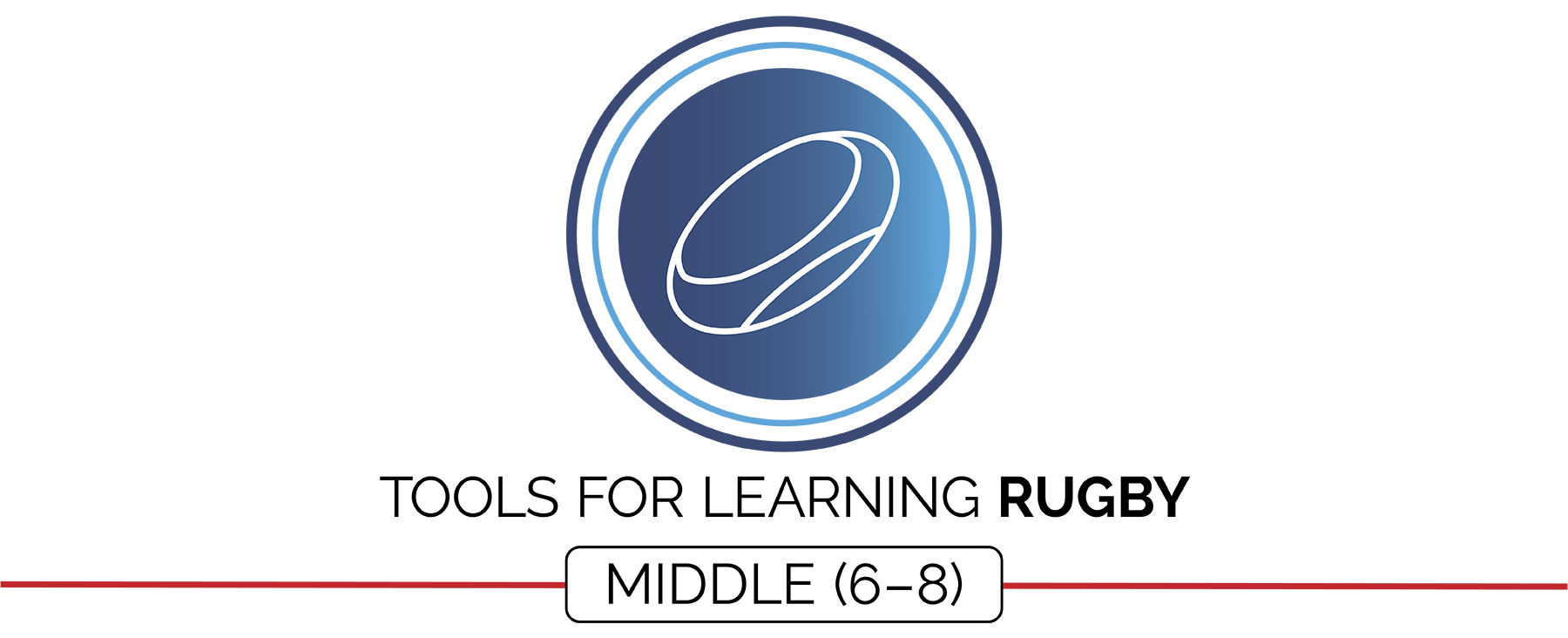Created by: Katie Pennamped & Aaron Hart
Special Contributions: Deedi Boland
Design: Jennifer Truong
Games that resemble Rugby appear as far back in history as 300 BC in Greece. The modern version of the sport was created at Rugby School in Rugby, Warwickshire (England) in the 19th Century. This recreational game of the early 1800’s was first formalize in 1857 in a match in Scotland between Edinburgh University and Edinburgh Academicals (AKA “the Accies”). The Edinburg Accies still operate as a formal Rugby Union Football Club and are the oldest rugby club in Scotland. Worldwide, rugby is an incredibly popular sport and has influenced Football, Australian-rules Football, and the fashion world (ala the Rugby Shirt).
Module Documents
Complete Module Packet:
Module Overview:
Required Materials:
All Module Activities:
Sample Lesson Plan:
Academic Language Cards:
Grip Cue Chart:
Ball Handling Cue Chart:
Passing Cue Chart:
Try Cue Chart:
Universal Design Adaptations:
Activity Plans
Rugby Tag:
Stationary Passing:
Leader Ball:
Star Passing Drill:
Monkey In The Middle:
Sharks & Minnows:
Gauntlet:
Partner Score:
Learning Lanes:
Ultimate End Ball:
Flag Rugby:
Assessments
Holistic Performance Rubric:
Purposeful Practice Plan:
Teamwork Exit Slip:
Academic Language Quiz:
Teacher Evaluation
Teacher Self-Evaluation/Reflection Guide:
Planning Tools
Blank Lesson Plan Template:
Can’t see the file links? Register for FREE today to access all of the modules. SIGN UP HERE
National Standards and Outcomes Focus for Rugby
Standard 1
- S1.M2: Throws with a mature pattern for distance or power appropriate to the practice task (6); Throws with a mature pattern for distance or power appropriate to the activity in a dynamic environment (7); Throws with a mature pattern for distance or power appropriate to the activity during small-sided game play (8).
- S1.M3: Catches with a mature pattern from a variety of trajectories using different objects in varying practice tasks (6); Catches with a mature pattern from a variety of trajectories in small-sided game play (7).
- S1.M4: Passes and receives with hands in combination with locomotor patterns of running and change of direction & speed with competency in invasion games such as basketball, flag football, or team handball (6).
- S1.M5: Throws, while stationary, a leading pass to a moving receiver (6); Throws, while moving, a leading pass to a moving receiver (7); Throws a lead pass to a moving partner off a dribble or pass (8).
- S1.M6: Performs pivots, fakes, and jab steps designed to create open space during practice tasks (6); Executes at least one of the following designed to create open space during small-sided game play: pivots, fakes, jab steps (7); Executes at least two of the following to create open space during modified game play: pivots, fakes, jab steps, screens (8).
- S1.M7: Performs the following offensive skills without defensive pressure: pivot, give & go fakes (6); Performs the following offensive skills with defensive pressure: pivot, give & go, fakes (7); Executes the following offensive skills during small-sided game play: pivot, give & go, fakes (8).
- S1.M11: Maintains defensive ready position, with weight on balls of feet, arms extended and eyes on midsection of the offensive player (6); Slides in all directions while on defense without crossing feet (7); Drop-steps in the direction of the pass during player-to-player defense (8).
- S2.M1: Creates open space by using locomotor movements (e.g., walking, running, jumping & landing) in combination with movement (e.g., varying pathways; change of speed, direction or pace) (6); Reduces open space by using locomotor movements (e.g., walking, running, jumping & landing, changing size and shape of the body) in combination with movement concepts (e.g., reducing the angle in the space, reducing distance between player and goal) (7); Opens and closes space during small-sided game play by combining locomotor movements with movement concepts (8).
Standard 2
- S2.M2: Executes at least one the following offensive tactics to create open space: moves to open space without the ball; uses a variety of passes; uses pivot, fake or give & go (6); Executes at least two of the following offensive tactics to create open space: give & go; a variety of passes; fakes, pivot) (7); Executes at least three of the following offensive tactics to create open space: moves to create open space on and off the ball; uses a variety of passes, fakes, and pathways; give & go (8).
- S2.M3: Creates open space by using the width and length of the field/court on offense (6); Creates open space by staying spread on offense, and cutting and passing quickly (7); Creates open space by staying spread on offense, cutting and passing quickly, and using fakes off the ball (8).
- S2.M4: Reduces open space on defense by making the body larger and reducing passing angles (6); Reduces open space on defense by staying close to the opponent as he/she nears the goal (7); Reduces open space on defense by staying on the goal side of the offensive player and reducing the distance to him/her (third-party perspective) (8).S2.M5: Reduces open space by not allowing the catch (denial) or by allowing the catch but not the return pass (6); Reduces open space by not allowing the catch (denial) or anticipating the speed of the object or person for the purpose of interception or deflection (7); Reduces open space by not allowing the catch (denial) and anticipating the speed of the object or person for the purpose of interception or deflection (8).
- S2.M6: Transitions from offense to defense or defense to offense by recovering quickly (6); Transitions from offense to defense or defense to offense by recovering quickly and communicating with teammates (7); Transitions from offense to defense or defense to offense by recovering quickly, communicating with teammates and capitalizing on an advantage (8).
- S3.M7: Identifies the components of skill- related fitness (6); Distinguishes between health-related and skill-related fitness (7); Compares and contrasts health-related fitness components (8).

